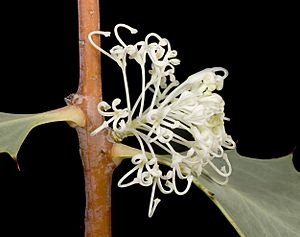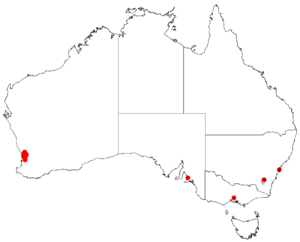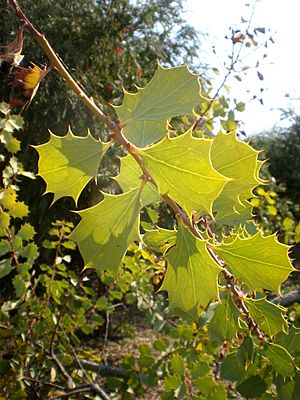Snail hakea facts for kids
Quick facts for kids Snail hakea |
|
|---|---|
 |
|
| Hakea cristata inflorescence | |
| Conservation status | |
| Scientific classification | |
| Genus: |
Hakea
|
| Species: |
cristata
|
 |
|
| Occurrence data from Australasian Virtual Herbarium | |
The Snail Hakea (scientific name: Hakea cristata) is a special kind of shrub. It belongs to the Proteaceae plant family and grows naturally in Western Australia. This plant is quite pretty with its spiky leaves and lots of creamy white, round flowers. These flowers bloom mainly during the winter months.
What Does It Look Like?
The Snail Hakea is a shrub that can grow from 1 to 3.5 metres (3 to 11 ft) tall. It often has many stems and smooth, smaller branches.
Its leaves grow one after another along the stem. They are shaped a bit like an egg, getting narrower towards the bottom. Each leaf is about 4.5 to 8 centimetres (1.8 to 3.1 in) long and 2 to 5 cm (0.8 to 2.0 in) wide. The edges of the leaves are toothed and prickly, which makes them feel spiky. When new leaves grow, they are smooth and have a lovely pink-red color. The older leaves are smooth and mid-green, with a strong central vein that ends in a sharp point.
The Snail Hakea's flowers are a creamy white color and have a faint scent. Each group of flowers (called an inflorescence) has between 24 and 42 individual flowers. They appear where the leaves meet the stem, usually from May to August.
The fruit of the Snail Hakea is very unique, which helps tell it apart from other plants. It has a toothed ridge, like a crest, running along each side of the bottom part. This crest ends in a triangular horn at the top. The fruit grows at an angle on its stalk and is egg-shaped, about 3.5 to 5 cm (1.4 to 2.0 in) long and 2.3 to 3 cm (0.91 to 1.18 in) wide. Its surface has spiky, toothed ridges. Sometimes, the fruit stays green even when it's fully grown. Inside, the seeds are winged and oval-shaped, about 3 to 3.4 cm (1.18 to 1.34 in) long.
Where Did Its Name Come From?
The Snail Hakea was first officially described by a botanist named Robert Brown in 1830. He wrote about it in a book called Supplementum primum prodromi florae Novae Hollandiae.
The second part of its scientific name, cristata, comes from a Latin word. Cristatus means "tufted" or "crested." This name was chosen because of the crests, or ridges, found along the sides of the plant's fruit.
Where Does It Live?
The Snail Hakea mostly grows in specific areas of Western Australia. It likes to live in places with special red-brown soils (called lateritic soils) and rocky areas made of granite. You can find it in the jarrah forests of the Darling Scarp, which is a hilly area. It grows between the towns of Chittering and Mundaring.
This plant usually grows in open woodlands where Eucalyptus wandoo trees are common.
See also
 In Spanish: Hakea cristata para niños
In Spanish: Hakea cristata para niños



